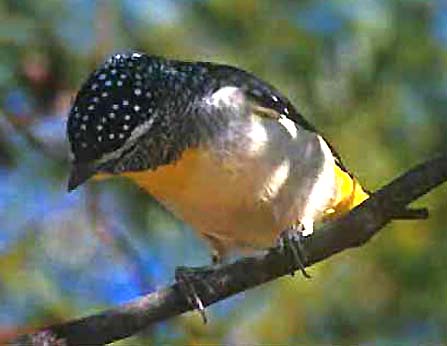 The Pardalotes are a small Australasian family composed of just four species
in the genus Pardalotus. In size and shape they might remind American
observers of small, colorful nuthatches (e.g., they frequently hang upside
down when foraging), but they are not restricted to tree trunks or cones
in their foraging, but glean throughout the foliage. All species are colorful,
active, and have short black bills. Many feed on the sugary lumps exuded
by psyllids (small plant-sucking insects living on Eucalyptus trees). Simpson
& Day (1996) say that the "clicking sounds made by the bills of these
birds when removing lerps is a characteristic of their feeding." Except
when breeding, pardalotes are generally feeding high up in Eucalyptus,
making them difficult to observe. Several species are migratory and make
substantial seasonal movements.
The Pardalotes are a small Australasian family composed of just four species
in the genus Pardalotus. In size and shape they might remind American
observers of small, colorful nuthatches (e.g., they frequently hang upside
down when foraging), but they are not restricted to tree trunks or cones
in their foraging, but glean throughout the foliage. All species are colorful,
active, and have short black bills. Many feed on the sugary lumps exuded
by psyllids (small plant-sucking insects living on Eucalyptus trees). Simpson
& Day (1996) say that the "clicking sounds made by the bills of these
birds when removing lerps is a characteristic of their feeding." Except
when breeding, pardalotes are generally feeding high up in Eucalyptus,
making them difficult to observe. Several species are migratory and make
substantial seasonal movements.
The Striated Pardalote (left or above in a nice shot by Ed Harper) comes in a variety of fairly distinctive plumages across a broad geographic range, and has been split by some into as many as four or five species. The one shown here is the nominate race P. s. striatus, the "Yellow-tipped Pardalote" that breeds in Tasmania and is migratory widely throughout southeast Australia. Most of the population leaves Tasmania in the fall and winters as far north as Queensland. Some mainland breeding subspecies are black-headed, but all have the broad bicolored supercilium: yellow distally and white behind. |
 The
Spotted Pardalote (right, in another Ed Harper photograph)
is a widespread breeder throughout mainland Australia. It, too, is variable
with a red-rumped form in wetter habitat and a dry-country yellow-rumped
form that used to be considered a separate species ("Yellow-rumped Pardalote
P.
xanthopygus"). To many observers, pardalotes are most noticeable when
breeding in the ground. The Spotted Pardalote uses a tunnel built in clay
or soil that ends in a lined chamber, and may ignore the approach of birders.
These nest holes are widely spaced since pairs defend the site from other
birds. In contrast, Striated and Forty-spotted Pardalote P. quadragintus
(a Tasmanian endemic) breed primarily in loose colonies, using various
hollows in trees or in earthen banks. The Forty-spotted seems only to be
successful in such small colonies (Blakers et al. 1984, Simpson & Day
1996). The final species is the Red-browed Pardalote P. rubricatus
of dry woodlands of northern Australia. It is nomadic in its movements,
and is decidedly more common in the western portions of its range (Schodde
& Mason 1999, Morcombe 2000). It has a larger bill than the pardalotes
shown in these photos, and adults are pale-eyed. The
Spotted Pardalote (right, in another Ed Harper photograph)
is a widespread breeder throughout mainland Australia. It, too, is variable
with a red-rumped form in wetter habitat and a dry-country yellow-rumped
form that used to be considered a separate species ("Yellow-rumped Pardalote
P.
xanthopygus"). To many observers, pardalotes are most noticeable when
breeding in the ground. The Spotted Pardalote uses a tunnel built in clay
or soil that ends in a lined chamber, and may ignore the approach of birders.
These nest holes are widely spaced since pairs defend the site from other
birds. In contrast, Striated and Forty-spotted Pardalote P. quadragintus
(a Tasmanian endemic) breed primarily in loose colonies, using various
hollows in trees or in earthen banks. The Forty-spotted seems only to be
successful in such small colonies (Blakers et al. 1984, Simpson & Day
1996). The final species is the Red-browed Pardalote P. rubricatus
of dry woodlands of northern Australia. It is nomadic in its movements,
and is decidedly more common in the western portions of its range (Schodde
& Mason 1999, Morcombe 2000). It has a larger bill than the pardalotes
shown in these photos, and adults are pale-eyed.
Pardalotes were once placed with flowerpeckers in the Dicaeidae, but Sibley & Ahlquist (1990) and Sibley (1996) showed that this small group of birds is one of the great corvid assemblage that arose in Australasia. Biochemical analysis shows that they are most closely related to scrubwrens, thornbills, bristlebirds and allies; indeed, Sibley & Ahlquist (1990) and Sibley (1996), followed by Simpson & Day (1996), place all these groups together under a much broadened Pardalotidae. The more conservative approach (which I follow here, and which is the apparent approach of the Handbook of the Birds of the World series) is to place the pardalotes in their own family and group together the scrubwrens, thornbills, etc., in their own family, the Acanthizidae [Australo-Papuan Warblers]. |